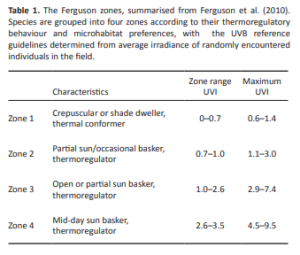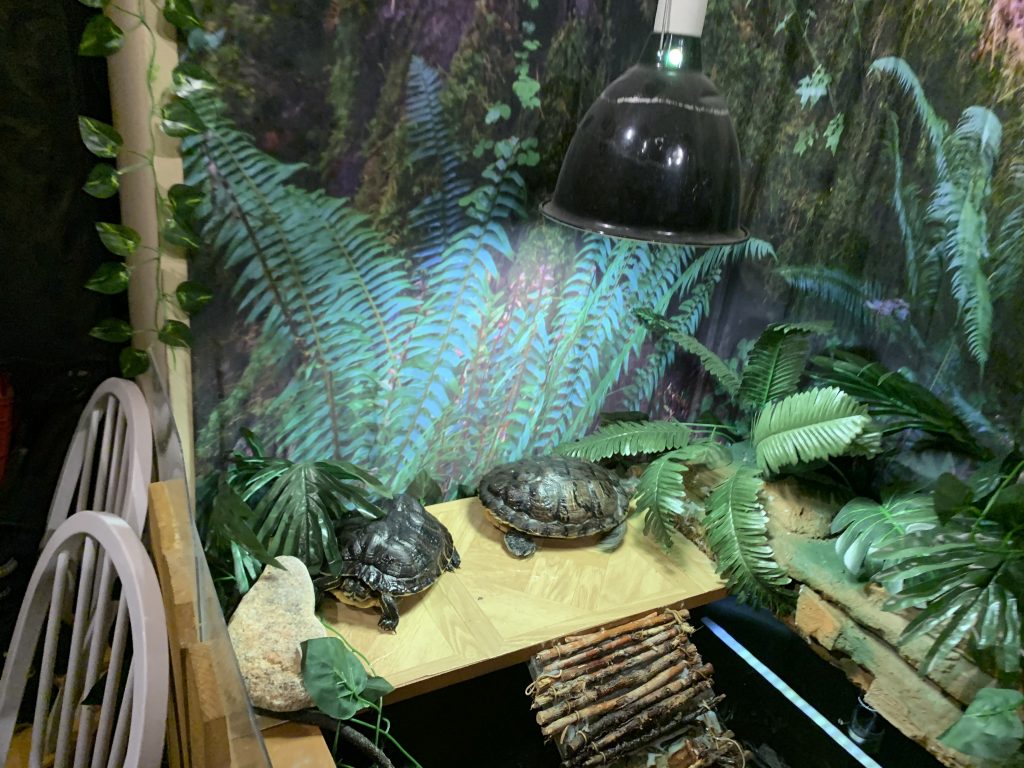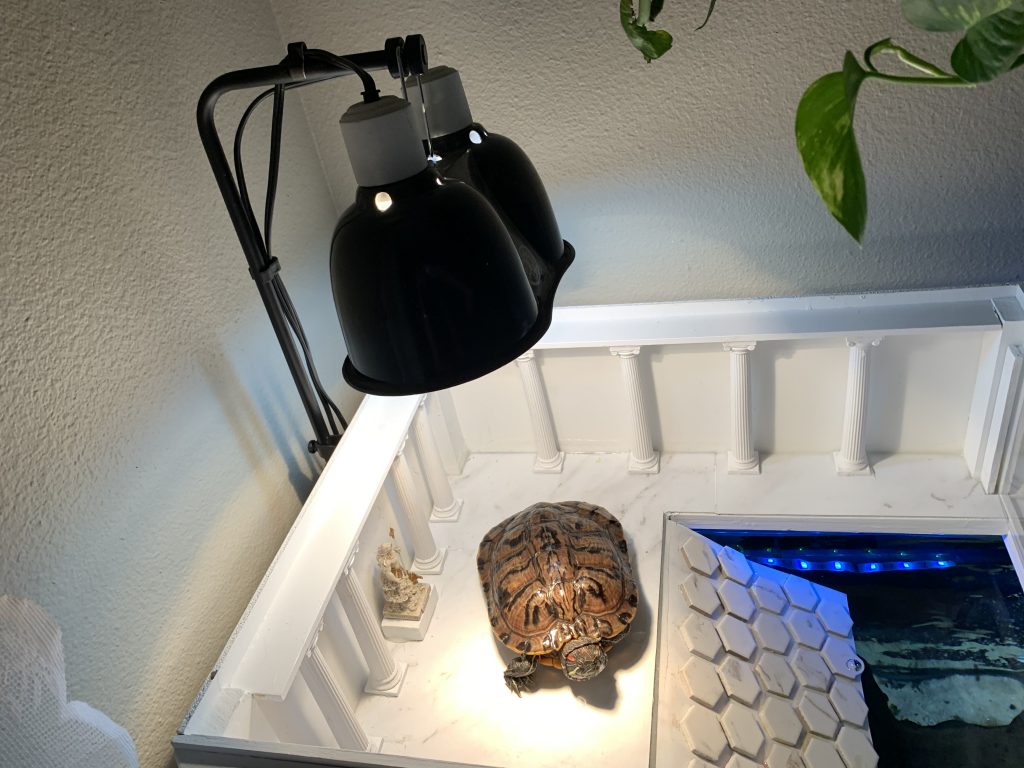Turtle Lighting
Turtle Lighting
Long Live Your Turtle LLC is an Amazon Associate and will earn a small commission from qualifying purchases when Amazon product links on this page are utilized. Additional Disclaimer information is provided at the bottom of this page.
Key Basking Light Tips:
Key Turtle Tips:
You need heat, UVA and UVB spectrum bulbs
Heat bulb must produce the correct temperature at your basking surface and UVB bulb must be effective at installed distance
Light fixtures must be able to withstand high temperatures due to bulb heat
Bulbs should be safely located above basking area
If you have not read up on it yet, please read about turtle basking! Find it here: https://www.longliveyourturtle.com/turtle-basking-area once you do, head back this way to learn how to set up a the lights for a proper basking area.

To create an adequate basking area, you need to light it with a make-shift sun. Woaw… that sounds impossible. But think about what the sun provides us. Heat of course. You can get real toasty spending time under the sun. When the sun is not shining down though and it is not directly shining on you, it can get incredibly cold!
How about if you expose yourself to too much sunlight? Besides possibly overheating, you would probably burn right? Well that is because of solar radiation, more specifically, UltraViolet radiation, which is invisible to the human eye! No, getting sunburned is not beneficial to you or I even if it might result in a sexy bronze. Wear sunscreen! However, as we discussed (https://www.longliveyourturtle.com/turtle-basking-area), turtles require UVB light to produce Vitamin D3 and to help them properly metabolize calcium and other nutrients. Turtles lacking the appropriate amount of UVB light can lead to poor shell health and metabolic bone disease. A lack of UVB light for too long will lead to a turtle’s death 🙁
Additionally, UVA has been shown to possibly improve the health of your turtle. Most basking specific bulbs or UVB specific bulbs provide UVA, so you do not need to get a third bulb for your turtle.
Don’t worry though! There have been lots of improvements in pet turtle keeping that have led to products that easily satisfy a turtle’s lighting needs. So for your turtle you need your basking area to provide two types of light, UVA and UVB radiation, and heat!
IMPORTANT! Not all reptiles need the same UVB exposure. Think a reptile that lives deep in the rainforest does not require the same UVB exposure as a lizard that lives in the desert. Additionally, not all reptiles in the same environment take advantage of the sun the same way. The same is true for turtles. Even turtles that live in similar environments might bask different amounts (and therefore require different amounts of UVB). An awesome, simplified way of determining your turtle’s typical UVB exposure requirement is knowing its particular Ferguson Zone. The Ferguson Zone was presented How much UV-B does my reptile need?
The table below was taken from The UV-Tool, a guide to the selection of UV lighting for reptiles and amphibians in captivity, by Frances Baines, Joe Chattell, James Dale, Dan Garrick, Iri Gill, Matt Goetz, Tim Skelton and Matt Swatman which heavily references Ferguson et al. 2010, 2014. Many regular basking species of turtles fall in Zone 3 and 4.

An excellent study was put together but JZAR (click here) that measured the UVB output of various products offered at pet stores for reptile use. The results are telling and this is a great source to help determine your turtle’s setup.
There has been lots of debate on whether UVB can penetrate water. In my opinion and from my own research, it is not guaranteed that enough UVB will penetrate the water and your turtle may not get enough. I recommend placing it over your basking area to ensure your turtle will get the UVB light they need. But don’t take my word for it!
Remember to replace this bub per manufacturer’s recommendation as they will stop producing adequate UVB over time.

Basking or Heat Bulb – Halogen or Incandescent Bulb
This bulb produces heat! Typically an incandescent or halogen bulb that produces a yellow/white luminescence, you want a reptile specific light bulb as it is designed to concentrate the heat this bulb produces directed at your basking area. You will notice wattage is an important property of your bulb. Wattage for a heat lamp relates to the intensity of the heat emitting from the bulb. So depending on the location of your light fixture, the size of your basking area and the reflectivity of your lamp, you want a bulb that produces the right temperature on your basking area. This can be trial and error but is simple to track using a thermometer like this one https://amzn.to/3o7MWJr.
Many of these bulbs also emit beneficial UVA light. While not required it has been shown to help with certain natural activities like breeding and overall health.
Check out a basking/heat bulb here (confirm wattage for your setup): https://amzn.to/3hkWn74

UVB Bulb – T5 Lamp (Tube)
UVB (UltraViolet -B)– is best emitted by a T-5 fluorescent tube bulb. The tube has been shown by various tests to be the optimal way to ensure your turtle is getting the right UVB exposure. A great study was done by JZAR (see report here) that measured UVB output from different types of bulbs showing the T5 bulbs as superior for Ferguson Zone 3 and 4 turtles (see discussion above about the Ferguson Zone). Of course other options exist and are discussed below.
Check out this bulb here (confirm wattage): https://amzn.to/2RMwUJe

UVB Bulb – Compact Fluorescent Bulb (Not Ideal)
There are several mini fluorescent bulbs available at pet stores for turtles. I actually used these for a while as they are directly advertised for turtle use. However, it has been shown that these bulbs are not optimal and sometimes not even adequate for turtles. However, it is important that this option is presented as some keepers have still had success with them.
Check out this bulb here: https://amzn.to/3uGvj6i

2-in-1 Bulb – Mercury Vapor Bulb
Now we have discussed two different primary bulbs required for an adequate turtle basking area. It might please you to know that there is a bulb that combines both heat and UVB. It is a Mercury vapor bulb. While more expensive, you only need one bulb and one light fixture so the pros are obvious. I use both the dual bulb and single bulb method for my setups. Really just matters what you want to look at and what you can setup on your individual enclosure.
Many of these bulbs also emit beneficial UVA light. While not required it has been shown to help with certain natural activities like breeding and overall health.
Check out this bulb here (confirm wattage): https://amzn.to/2RMwUJe
Now there are essentially three types of lamp fixtures to choose from when it comes to housing your heat and UVB or 2-in-1 bulbs. Basking lamp fixtures should be designed to withstand high heat (wattage). It is safest to stick to the reptile specific brands as they are designed to not only take the heat but also magnify it toward the basking area (reflective surface).
Deep Dome
The deep dome is a classic lamp fixture built for basking bulbs, mercury vapor bulbs and compact UVB bulbs. I personally use this bulb with my 2-in-1 Mercury vapor bulb where this light fixture is the only one I need for the basking area.
Check out this dome here: https://amzn.to/2Q7DaKV

T5 Hood
A hood is required for the T5 lamp bulbs. These are specific hoods that are sized for the T5 bulb specifically as well as the length of the bulb.
Check out a T5 Hood for a 14″ bulb here: https://amzn.to/3khUMjf

Mini Deep Dome Combo
The mini deep dome combo is two smaller versions of the deep dome combined into one. This lamp is great when you want to put your basking bulbs relatively close to the basking area. It is compact and can fit both heat bulbs and compact UVB bulbs. Be careful and know that sometimes compact UVB bulbs still stick out the bottom a little bit and your fixture will not sit flat on a screen. As mentioned above, compact bulbs are not ideal for providing UVB for your turtle,
Check out this dome here: https://amzn.to/3vVg9dj

Clamp Lamp
The last style is one I use for specific setups. The clamp lamp does exactly as the name suggests, it can clamp to appropriate features near your basking area. Whether this is the side of your tank or a custom addition it allows you to avoid hanging or having your lamp rest on part of the tank setup. Keep in mind that you typically cannot rotate the lamp straight down when clamped vertically and your light will shine at an angle, which is not preferred. It can also hold your light close to things in your tank that might melt, like the plastic trim around the rim of your tank. Just take heed and consider this before you choose this type. Most clamp lamps fit all basking type bulbs. If it is not reptile specific just make sure it is designed for the wattage of the basking bulb you plan on using.
Check out this lamp here: https://amzn.to/2RMx3MM


Adjust Height of Lamp!
If your living space ambient temperature fluctuates (e.g. 55 deg in the winter and 90 deg in the summer) consider buying an adjustable stand that allows you to move your light closer or farther away from the basking area to modify the temperature. This can also help to set a height for your lamp in general. Check the suggested distance for the UVB bulb as well to make sure enough UVB reaches the basking area for your turtle.
DIY tip: If you need your light to hang higher than the screen top on the tank, you can use a hanging plant hook or a reptile specific lamp like the one’s linked here: https://amzn.to/2VevoOX
CAUTION! The height suggestions provided in the picture on the left are not guaranteed locations. Please measure the actual temperature of your basking area where your turtle will bask. Also reference the required height of the UVB bulb you are using. You can get a cheap thermometer that you can use dry or wet here. https://amzn.to/35L2FWi
How long should the lights stay on?
Easy! Match the sun! Your turtle rests and sleeps when the sun goes down and they no longer need to regulate their body temperature like they do during the day. Keeping the light on 24/7 will confuse and potentially stress your turtle and could cause health issues. If you live somewhere where winters and darkness are prolonged, just keep it at summer day length. I have my lights on for 10 hours. I recommend 9 to 11.
Word of CAUTION!
Nothing is free of hazard! It has been reported that basking bulbs have burst! This could be a result of water splashing onto them or just complete failure. Precarious setups can also lead to disaster! It is recommended that you put a screen between your lamp and your basking area to reduce the risk of your turtle getting injured from something like this happening.
Examples of Basking Area Lighting:

Deep Dome with Mercury Vapor Bulb (2-in-1 bulb emitting both UVA and UVB light)
Deep Dome -> https://amzn.to/3f7Qxn1
Mercury Vapor Bulb (UVA and UVB) -> https://amzn.to/3hkWn74
Optional: Light Stand -> https://amzn.to/3hiX0Oy

Mini Deep Dome with compact fluorescent and 50 watt heat bulb with a stand (REMEMBER, NOT A RECOMMENDED SETUP)
COMBO – Mini Deep Dome +Heat Bulb (UVA) + Compact Fluorescent (UVB)-> https://amzn.to/3hiVJqS
Optional: Light Stand -> https://amzn.to/3o4LlUV

Mini Deep Dome with compact fluorescent and 50 watt heat bulb on a screen
-
Mini Deep Dome -> https://amzn.to/3uDT274
- Deep Dome -> https://amzn.to/3o3YHRr
-
Heat Bulb (UVA) -> https://amzn.to/2RGeLMX
-
Fluorescent (UVB) -> https://amzn.to/2Qb9Sey
Optional: Aquarium screen top (check sizing) -> https://amzn.to/3hhDDFK

Clamp lamp with Mercury Vapor Bulb (2-in-1 bulb emitting both UVA and UVB light)
- Clamp Lamp ->https://amzn.to/2RMx3MM
- Mercury Vapor Bulb (UVA and UVB) -> https://amzn.to/3hkWn74
Longliveyourturtle.com is an educational site for aquatic turtle owners, future owners and hobbyists interested in general turtle care information. All information provided is accurate to the best of Long Live Your Turtle LLC’s knowledge and belief, but is presented for educational and sometimes entertainment purposes only. No information on this site should be considered authoritative with respect to human health or animal health and husbandry. Full disclaimer can be found at here.